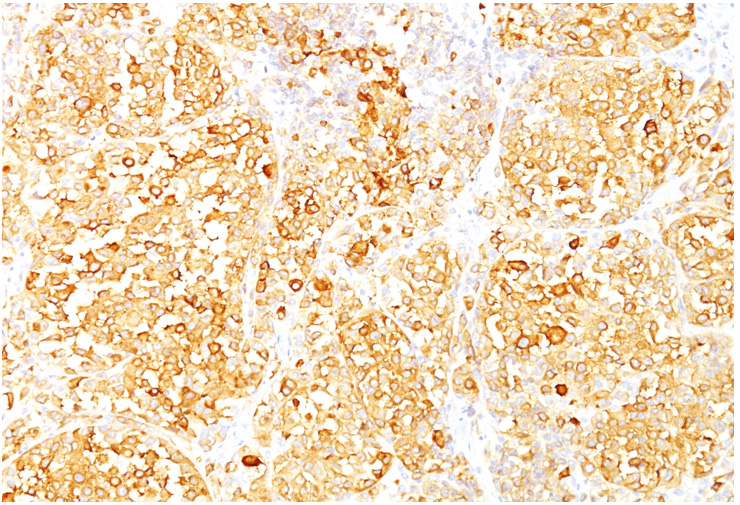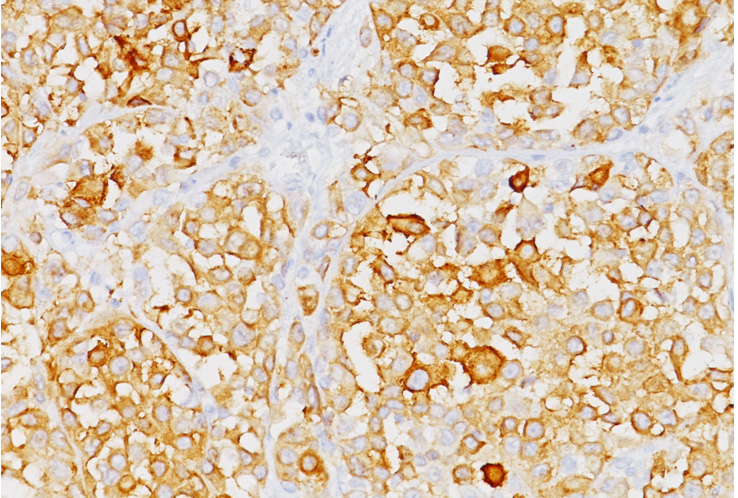MelanA (MLANA) Mouse Monoclonal Antibody [Clone ID: M2-9E3]
CAT#: AM32813PU-S
MelanA (MLANA) mouse monoclonal antibody, clone M2-9E3, Purified
Need it in bulk or conjugated?
Get a free quote
CNY 5,606.00
货期*
5周
规格
Specifications
| Product Data | |
| Clone Name | M2-9E3 |
| Applications | ELISA, FC, IF, IHC, IP, WB |
| Recommend Dilution | ELISA: Use BSA free Antibody for Coating. Western Blot: 0.5-1 µg/ml. Immunoprecipitaion: 0.5-1 µg/500 µg protein lysate. Flow Cytometry: 0.5-1 µg/106 cells. Immunofluorescence: 1-2 µg/ml. Immunohistochemistry on Frozen and Formalin-Fixed Paraffin Sections: 0.5-1 µg/ml for 30 minutes at RT. Staining of formalin-fixed tissues is enhanced by boiling tissue sections in 10 mM citrate buffer, pH 6.0 for 10-20 min followed by cooling at RT for 20 min. Positive Control: SK-MEL-13 and SK-MEL-19 Melanoma cell lines; Melanomas. |
| Reactivity | Human, Mouse, Rat |
| Host | Mouse |
| Clonality | Monoclonal |
| Immunogen | Recombinant Human MART-1 protein. |
| Specificity | This antibody recognizes a protein doublet of 20-22kDa, identified as MART-1 (Melanoma Antigen Recognized by T cells 1) or Melan-A. It is also a useful positive-marker for angiomyolipomas. It does not stain tumor cells of epithelial, lymphoid, glial, or mesenchymal origin. The clone M2-9E3 MART-1 antibody labels melanomas and other tumors showing melanocyte differentiation (Kawakami et al, 1997). The antibody has been highly characterized, including by Immunohistochemistry, Immunofluorescence, Western blot and Immunoprecipitation, and the specificity of the antibody for Melan-A has also been validated by Melan-A siRNA knockdown (Hoashi et al, 2005). Additionally, the Melan-A antibody has been used in combination with other melanocyte differentiation markers to help confirm or exclude melanocyte histogenesis (Collins, 2012; Mihic-Probst, 2012). It is important to note that Melan-A expression is not restricted to melanoma, and may also be detectable on some other type of tumors (reviewed in Campoli, 2012). The exact eptiope recognized by the Melan-A antibody has not been mapped. However, the Melan-A epitope recognized by this antibody appears to be different than that recognized by the MART-1 antibody clone M2-7C10 (Cat.-No AM32812PU) (Kawakami, 1997). Researchers often use more than one antibody against a given specificity to help follow up and validate results. Hence, it may be useful to use both the Cat.-No AM32812PU and Cat.-No AM32813PU antibodies in parallel to obtain additional information about Melan-A expression. Cellular Localization: Cytoplasmic. |
| Formulation | 10mM PBS State: Purified State: Liquid purified IgG fraction from Bioreactor Concentrate Stabilizer: 0.05% BSA Preservative: 0.05% Sodium Azide |
| Concentration | lot specific |
| Purification | Affinity Chromatography on Protein A/G |
| Conjugation | Unconjugated |
| Storage Condition | Store undiluted at 2-8°C. |
| Predicted Protein Size | 20-22 kDa (doublet) |
| Gene Name | melan-A |
| Database Link | |
| Background | Melan-A also known as MART-1 (Melanoma Antigen Recognize by T cells 1), is an 18 kDa melanocyte differentiation antigen recognized by T cells. Melan-A is expressed in melanosomes and the endoplasmic reticulum. Melan-A is the most widely used marker for identifying malignant melanoma (Campoli, 2012), a highly aggressive and deadly form of skin cancer which may be curable when caught early. Melan-A specific monoclonal antibodies have utility for evaluating suspected melanocyte lesions by immunohistochemistry as they have both high sensitivity (75-92%) and specificity (95-100%) for melanoma (Campoli, 2012, Oshie, 2012). |
| Synonyms | Melan-A protein, MLANA, Antigen SK29-AA, LB39-AA, MelanA, MART1 |
| Reference Data | |
Documents
| Product Manuals |
| FAQs |
| SDS |
Resources
| 抗体相关资料 |
Customer
Reviews
Loading...


 United States
United States
 Germany
Germany
 Japan
Japan
 United Kingdom
United Kingdom
 China
China



